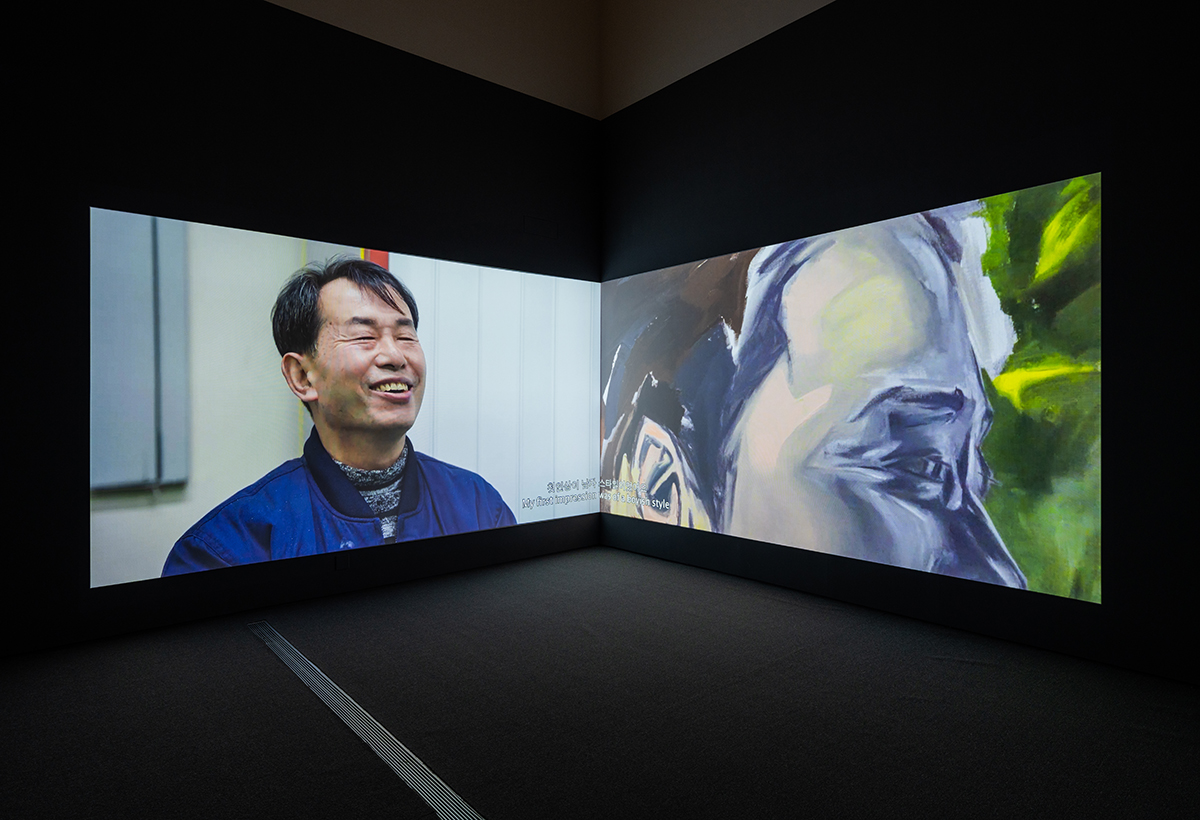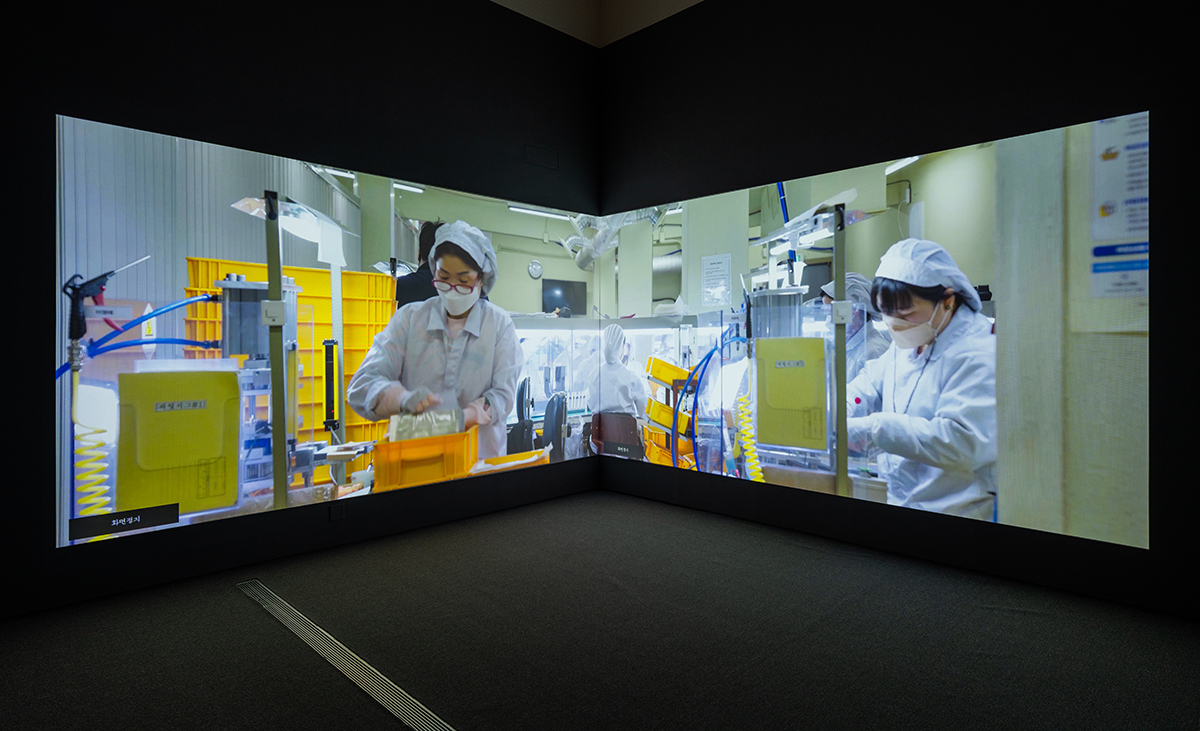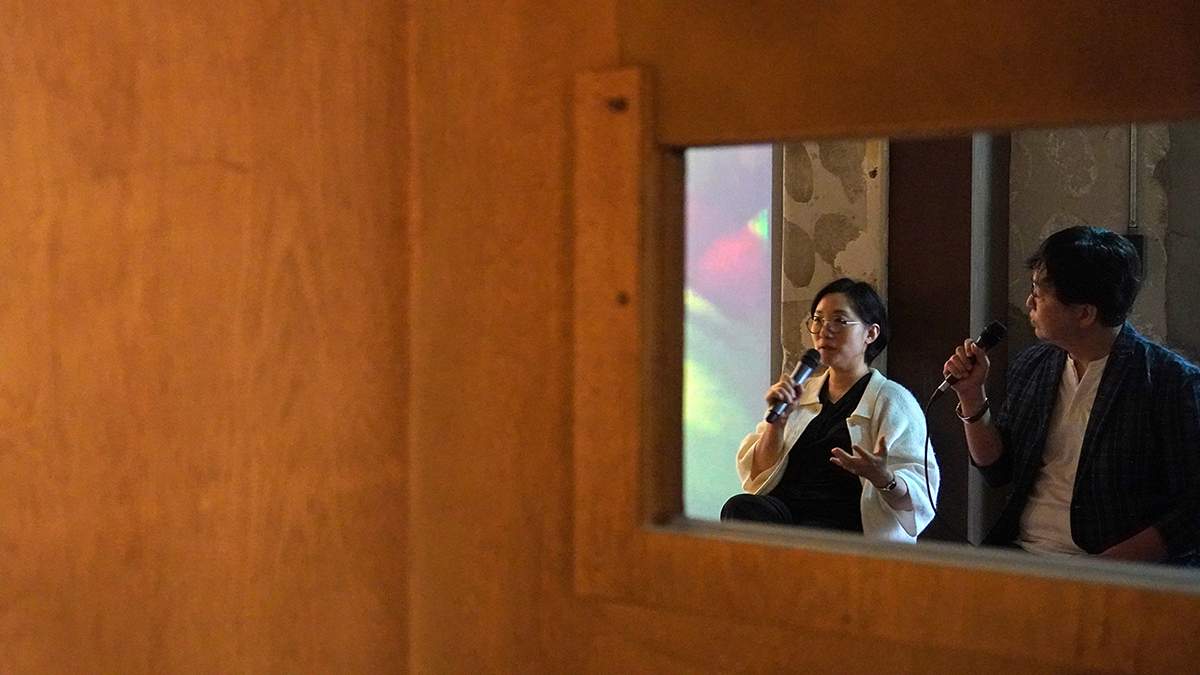A Chunk of Lonely Dreams_ Factory girls, Matsuko, and I
Jaehoon Choi (Film critic)

Our Joyful Young Days, 2022_2-channel video, painting (by. Mina Ham), 25min 49sec, Co-directed by Yeeun Kang, Photo courtesy: MMCA
Sometimes our imagination is surprisingly limited, and it embarrasses us. I realized that when I visited the former dorm rooms for factory girls. We are often deluded that imagination gives us boundless possibilities, but our experiences, backgrounds, and where we belong determine the scope. For me, the word ‘dorms’ evokes a nostalgic sentiment and makes me recall good memories. I thought it was where our dreams unfold and youthful energy dwells. However, the ‘site’ that used to be the dorm rooms for factory girls was too small and dark. So I felt the need to switch my imagination.
Then I start picturing a cold and cramped room without any romantic ambiance. In this new imagination, I become an exhausted factory girl who can barely get squeezed into a crowded room in a so-called ‘back-to-back’ house. With other girls breathing louder than each other, the noise, bigger than the tiredness itself, keeps me from sleeping at night. When will this end? When I cannot have a peaceful resting time all for myself at the end of the day, after I devoted my youth to hard labor, the word ‘hope’ sounds too unrealistic.

Disgust, Matsuko, Life
Imagination tends to be excessive while living hopeless days in a deserted life. Such a condition calls for a fantasy near self-delusion. As a factory girl, for which a ‘female laborer’ would be the more proper term today, I am living a life like a lost person. People often tell me I should go the right way, but I never learned how to read a map. Or, there was never the right way for me to go.
Unlike those who are desperately trying, I decided to do nothing. I never wished to be a swan to fly higher and farther among ducklings. I am content with being a duck among the flock. All I need at the end of an exhausting day is a little time to rest and to stop all the seemingly interminable flapping. In the morning, there comes another day I must endure after another, and I call it a life.
Then one day, I notice my heart suddenly flutters. The feeling of love that charmingly tickles my heart is utterly real, not an illusion. Money, time, or distance, none of these matters when it comes to love, and I do not have to fantasize about it. This is what makes people long for love. For some people, love is the only thing they can own out of the things they have dreamed of. It does not necessarily have to be mutual if it is only a crush. In that sense, love is quite economical.
Now, I invite Matsuko into my imagination, where I am a factory girl. Matsuko is the main character in the movie Memories of Matsuko 1), directed by Tetsuya Nakashima, from which the artist, Hyesoo Park, found her inspiration for this solo show, Monophobia. While everyone else is going forward, Matsuko seems to repeat her mistakes, devoting her whole heart to being loved. People judge Matsuko by the eyes of their world and feel ‘disgusted’ about her because she abuses herself, begging for love.
During her early years, Matsuko was forced to sacrifice herself for her sick sister. One day, Matsuko's father gives her a big smile for the first time when she imitates an actor's funny face. After that day, Matsuko makes a funny face whenever she tries to lighten the mood. She just wants to be loved. Later on, her yearning for love makes her depend upon others. She is not afraid of ruining her life if there is a hope of love. Gaining her father's attention with a funny face has grown into destroying herself to have someone love her. But the more she desires love, the lonelier she gets, and, in the end, even the loneliness abandons her.
Director Tetsuya presents a story of Matsuko’s life from her twenties when she is a teacher, then quits her job and leaves her family, through the age of 53 when she is found dead at the riverside—how a once lovely girl ends her life as a disgusting woman. The ironically bright color, contrasting with her miserable life, represents an illusory world that helps her withstand suffocating situations. Tetsuya chooses to put a colorful bandage over her wound rather than rubbing salt into it.
In the movie, the one who traces Matsuko’s life is her nephew, Sho, who only met her once, shortly in his childhood. His life may seem lame as well, but he still has an unachieved dream kept in his heart. When Sho organizes Matsuko's keepsake as his father has asked, he finds clues for stories of her life from seemingly insignificant objects. The old objects people still hold onto are not the trash they should take out, but are filled with memories they cannot let go of.
Memories and the objects that contain them stain my heart permanently, just like a once crumpled paper will never be smooth again. The stains make a way in my heart that abruptly brings the forgotten memories back to the present. The captivating scent of flowers on the day I got stood up, or the rough texture of my clothes on the day I broke up, all stay in the objects. I thought I erased them all, but the remaining stains grasp the memories of angry and painful, yet beautiful days, and lock them in a frame.
When we collect fragments of memories and stitch them together, they turn into a big volume of stories, and we call it ‘those days of the time.’ Hence, the piece Our Joyful Young Days, which Park carefully threaded with love stories of laborers, is not just about love in general, but a collective story of the time. Along with that work, the exhibition Monophobia summons the stories of factory girls who used to be confined in a space with dreadful loneliness, where the sound of others breathing is overwhelming.

Our, Probably Joyful, Young Days
Once called factory girls, they are not remembered by history as much as they were needed back then. But Park brings their names and lives into the present time to remember. She does not neglect those who have lived in the shadow and scarcely enjoyed the bright sunlight. She also sees a miserable life just as it is, where life resembles a worn-out shuttlecock helplessly falling from the high. She enables us to escape the limited imagination about other people’s lives and stops us from presumptuously asking, “Why don’t you try harder?” They fulfilled their duties, enduring the weight that society had burdened them. It is bitter that factory girls sacrificed all their youthful time for their families, but strangely, pity, sympathy, and longing always come along when recollecting old days.
During such a clamorous period, there must be some factory girls who had to work day and night to make dolls for other girls. When a factory girl pictures herself as a doll owner, not a doll maker, all the trivial details of a middle-class household are absent. She cannot come up with what she has never owned or known, such as her clothes, her room with a bed in a warm house, and how it feels to have them all. So the scene in her imagination goes beyond a realistic realm. There would be full of flowers or the Stairway to Heaven because the imaginary place she saw in The Wizard of Oz was the most splendid and happiest scene for her.
The distance between the inevitability of living and the fascination with death seems to be as far as Earth and Mars, but as near as skin and blood vessels at the same time. Whether it is life or death, or the life of being loved or being disgusted, what it means in Memories of Matsuko is not different from one another. It is crucial to realize that Matsuko’s life is a bottomless pit in the first place before we make a vain effort to pity her. She gradually learns that life is just for living, even though it seems uneventful. Thus, nobody has the right to waste emotion on sympathizing with anybody’s life.
Objects that embrace the feelings of their most passionate moments become a wordless history, replacing the label saying women who sacrificed their lives in an atrocious time, which only creates melodramatic sentiment. This is how the exhibition about the stories of laborers could bring out sympathetic emotions without instigation. In Park’s work, Our Joyful Young Days, people show innocent and pure smiles regardless of the time they went through. Whom would Matsuko remember as her first love? Whoever it is, she would have the most beautiful smile when telling her love story. For Matsuko, factory girls, and all of us, a life of loneliness may seem like broken pieces, but when the sunlight hits, it shines like grains of sand.
Not only factory girls in the past, but also those who have lived lonely lives have an ‘isolated room’ to keep their forsaken youthful days. What would a room that contains those days look like? Would a glimmering light come in for a withered heart? Someone has a room with a huge window facing the world, and someone has a room closed with walls and an immeasurable height. The memories of the room where they were trapped or voluntarily locked themselves up affect how they view others.
It was a time of deadly desolation, but it did not kill them. And I find it remains in the past, sitting there all by itself. At last, their stories reveal themselves truthfully as they are. It is quite thrilling to see how an artwork remembers stories that history has forgotten. It is almost like the past and present crash into each other, sparking a fire.
1) Memories of Matsuko (嫌われ松子の一生) is a Japanese musical film released in 2006, based on a Japanese novel by Muneki Yamada.

기쁜 우리 젊은 날, 2022, 2채널 영상, 회화(by.함미나), 25분49초, 강예은 공동연출, 사진제공: 국립현대미술관
외로운 꿈, 그 뭉툭한 덩이 _ 공순이, 마츠코 그리고……나
최재훈 (영화평론가)
상상력이란 녀석은 가끔 무척 빈곤해 염치없는 모습을 보인다. 노동자 기숙사였다는 공간을 직접 봤을 때, 그랬다. 상상력이란 무한의 영역이라 생각하겠지만, 자신이 속한 세상, 자신이 쌓아둔 경험, 그리고 자신이 발을 딛고 선 지대에 따라 그 크기가 무척 제한적이다. ‘기숙사’라는 명사는 나에게는 낭만적인 이름이었고, 경험이었다. 하루를 마치며 꿈을 꾸어보는 곳, 젊은 날의 열기가 머무는 곳이라 상상했다. 하지만 노동자 기숙사였다고 소개받은 ‘터’는 작고, 좁고, 어두웠다. 그래서 상상력의 전원을 껐다가 다시 켰다.
낭만적 정서를 지우고 좁고 차가운 방안을 떠올린다. 어두운 밤, 소위 벌집촌이라 불리었던 그 공간, 다닥다닥 붙은 사람들 사이에 제 몸 하나 겨우 뉘인 여성 노동자가 되어 본다. 내 숨소리 보다 더 큰 타인의 숨소리를 들으며 누운 시간, 피로보다 더 피곤한 소음이 잠을 방해한다. 언제 벗어날 수 있을까? 나의 청춘을 문질러 지운 시간의 끝, 내게 허락된 휴식의 시간조차 온전히 나의 것이 아닌 순간, 희망은 붙들기에 너무나 가늘고 짧은 것이다.
혐오, 마츠코, 삶
괴괴한 삶 속, 물기 없는 결핍의 시간을 살다보면 상상력은 과잉이 된다. 결국 자기기만에 가까운 판타지가 필요하다. 지금은 여성 노동자라고 하지만, 그때는 공순이라 불리던 나는 길을 잃은 것 같은 삶을 살고 있다. 사람들은 똑바른 길을 찾아 가라고 나침반을 건네기도 하지만, 나는 처음부터 나침반을 읽는 법을 배운 적 없는 길치다. 아니, 어쩌면 내겐 나아가야 하는 앞이 훤히 보이는 길이라는 것 자체가 없었던 건지도 모르겠다.
사람들의 애쓰는 마음과 달리 나는 그냥 살아 봐야겠다. 사실 커다란 날갯짓으로 자신의 존재를 알리는 새들 사이에서 나는 더 높이, 더 멀리 날겠다고 한 적이 없다. 촐랑거리는 몸짓으로 눈에 띄지 않는 무더기로 살아도 된다. 죽어야 끝날 것 같은 날개 짓을 멈추고 좀 쉬는 게 오늘 하루를 위한 나의 보상이다. 오늘도 살아남았으니, 그냥 내일도 좀 살면 안 되는 걸까? 생존의 시간이 모여 삶이 되는 사람, 나는 그런 사람이다.
그런 시간 속에 문득, 울컥, 마음의 두근거림을 느낀다. 돈이 없어도, 시간이 없어도, 상대방이 멀어도, 굳이 눈 감고 꿈꾸지 않아도 현실에서 가장 달콤하게, 내 살갗에 닿아 마음을 간질간질하게 하는 사랑의 감정만은 판타지가 아니라 현실이다. 그래서 사람들은 사랑을 갈구한다. 꿈꿔본 것 중에 내 것일 수도 있는 유일한 것이 사랑인 사람도 있다. 짝사랑이라면 상대방의 마음도 필요 없다. 그런 점에서 사랑은 꽤 효용이 좋다.
공순이에 빙의된 나의 상상력 속으로 마츠코를 불러낸다. 박혜수 작가가 영감을 얻었다는 나카시마 테츠야 감독의 영화 <혐오스런 마츠코의 일생> 속 그 마츠코다. 마츠코는 모두 더 나은 삶을 향해 달려가는 중에도, 오직 사랑받는 사람이 되겠다는 마음 하나로 제자리걸음을 걷는 것처럼 보이는 사람이다. 나를 망쳐서라도 기꺼이 사랑받는 여자로 살겠다는 욕망을 사람들은 그냥 자기가 속한 세계의 눈으로 평가하며 그 감정을 ‘혐오’라 표현한다.
마츠코는 아픈 여동생을 위해 희생을 강요당했던 소녀다. 어느 날 어떤 배우의 우스꽝스러운 표정을 따라하는 자신을 보며 아버지는 처음으로 활짝 웃어준다. 그날 이후 마츠코는 사랑 받기 위해 웃긴 표정을 짓는다. 단지 사랑받고 싶을 뿐이다. 사랑이 그리워, 사람에게 의지한다. 나를 망쳐서라도 좀 사랑받으며 살아보겠다는 마츠코의 삶. 망친 표정으로 상대의 마음을 얻은 경험은 결국 제 몸을 망쳐 마음을 얻는 방식으로 변질된다. 하지만 간절히 원할수록 더 외로워지고, 결국 그 외로움조차 등을 돌린 외톨이가 되었다.
테츠야 감독은 20대에 교사였다가 가출, 53세에 강변에서 죽은 마츠코, 사랑스러운 소녀였던 마츠코가 혐오스러운 마츠코가 되어 죽은 일대기를 보여준다. 마츠코가 처한 건조한 인생과 대비되게 화려하고 노골적인 색감은 너무나 건조해 숨을 쉬기 어려운 소녀가 살아남기 위해 만들어낸 일종의 환영의 세계이다. 테츠야 감독은 마츠코의 상처에 소금을 뿌리는 대신 화려한 밴드를 붙여 가리는 방법을 택한다.
영화 속에서 마츠코의 일생을 되짚어 가는 것은 어린 시절 스치듯 한번 만난 적이 있는 조카 쇼이다. 쇼 역시 남들이 보기에 시시한 삶을 살고 있지만, 아직 깨치지 못한 자신만의 꿈이 잡히지 않는 저 너머에 있는 그런 청춘이다. 아버지의 부탁으로 쇼는 마츠코의 유품을 정리하는데, 마츠코가 남긴 물건들은 시시해 보이지만, 그녀의 삶의 각 상자를 열어주는 각각의 열쇠가 된다. 사람들이 버리지 못한 물건은 미처 버리지 못한 쓰레기가 아니라, 아직 버릴 수 없는, 영혼이 녹아있는 기억이다.
기억, 그리고 그 기억을 담은 물건은 구겨진 종이처럼 마음에 인장을 남긴다. 다시 펼쳐 봐도 구겨진 종이에 남은 흔적은 마음의 길이 되어 잊고 있다가도 불쑥! 그 시절, 그 시간을 현재로 불러온다. 바람맞고 돌아오던 길에 맡았던 찬란한 꽃향기, 헤어지던 날 유난히 까끌거리던 옷감의 감촉 같은 기억이 간직해 둔 물건에 남는다. 활활 불태웠다고 생각하지만 사리로 남겨진 흔적처럼 기억은 찬란했던, 혹은 분했던, 아팠던 그 시간들을 끈질기게 붙잡아 한 덩어리로 만들어 한 장의 프레임에 가둔다.
그렇게 끊어진 필름 한 조각 같은 사람들의 기억을 모으고 펼쳐, 한 땀 한 땀 이어보면 아주 커다란 이야기가 되는데, 우리는 그것을 시절이라 부른다. 그래서 박혜수 작가의 ‘기쁜 우리 젊은 날’이 한 조각 한 조각 모아 퀼트처럼 정성스럽게 꿰어 펼친 노동자들의 사랑 이야기는 그냥 사랑 이야기가 아니라, 그 시절을 담은 이야기가 된다. 이번 전시 ‘모노포비아 – 외로움 공포증’에는 ‘기쁜 우리 젊은 날’. 그 사랑 이야기와 함께 지독한 외로움의 덩이에 갇힌, 자신의 숨소리 보다 더 큰 타인의 숨소리에 갇힌 공순이들의 이야기를 소환한다.

기쁜? 우리, 젊은, 날
공순이. 그 시대에는 그들이 필요했지만, 역사는 그들을 기록하지 않았다. 하지만 박혜수 작가는 그 이름, 그들의 삶을 현재로 불러와 기억해 준다. 하늘로 오르지 않고 자꾸 밟고 지나가야 하는 땅이 되는 삶을 외면하지 않는다. 너덜너덜해진 채로 하늘로 올라보지만 결국 툭 떨어지고야 마는 셔틀콕 같은 삶도 그 삶 그대로 본다. 박혜수 작가는 타인의 삶에 대한 우리의 빈궁한 상상력을 벗고, ‘왜 그렇게 밖에 못 살아?’라는 주제넘은 질문에서 우리를 벗어나게 한다. 그들은 세상이 주저앉힌 자리에서 달아나지 않고 제 몫을 살았던 사람들이다. 자신의 젊은 시간을 문질러 자신이 아닌 나머지 가족들을 위해 쪼개 써야 했던 공순이의 시간은 아프지만, 과거라는 희한한 녀석은 그리움과 안타까움과 연민이라는 친구의 손을 늘 잡고 나타난다.
월컹대는 시절, 공순이라 불리던 소녀들 중에는 또래 소녀를 기쁘게 해주는 물건을 밤낮없이 만들어야 했던 소녀도 있을 것이다. 물건을 만드는 소녀가 아니라, 물건을 소비하는 소녀를 꿈꿔보는 공순이의 상상 속에는 경험해 보지 못한 중산층 가정의 소소한 디테일이 담기지 못한다. 듬뿍 사랑을 받는 소녀의 집, 소녀의 방, 소녀의 침대, 소녀의 옷, 그리고 그 마음. 아는 것도 경험한 것도 없어서 상상할 수가 없다. 그래서 공순이의 상상 속 공간은 일상 속 공간을 뛰어 넘는다. 꿈속의 공간, 혹은 상상하는 공간은 꽃밭이거나 천국을 향한 계단이다. ‘오즈의 마법사’에서 봤던 가상의 공간이 그들이 본 가장 화려하고 행복한 ‘곳’이기 때문이다.
삶의 당위와 죽음의 매혹은 지구와 우주만큼이나 먼 것 같지만, 피부와 동맥 사이만큼 가깝다. <혐오스런 마츠코의 일생>은 삶과 죽음, 사랑받는 삶과 혐오에 빠진 삶 사이의 거리가, 그 인생의 가치가 사실은 크게 다르지 않다고 한다. 사실 텅 빈 마츠코가 안타까워 계속 물을 퍼 나르는 대신, 처음부터 깨어진 항아리라 채울 수 없다는 사실을 깨닫는 것은 중요한 일이다. 마츠코의 조카 쇼는 삶이 시시해 보일지 몰라도, 삶은 그냥 살아가는 거란 걸 깨닫는다. 그러니 우리는 그 시간과 그 사람을 동정하며 감정을 착취할 필요도 없고 그럴 자격도 없다.
극악한 시대에 희생된 여성이라는 표식 대신, 가장 뜨거웠던 순간의 감정이 녹아들어 있는 사물은 신파적 감성 대신 묵묵한 기록이 된다. 박혜수 작가의 ‘기쁜 우리 젊은 날’ 속 사람들은 지금 얼굴과 몸에 묻어있는 시간의 흔적과 상관없이 세상 가장 천진하고 맑은 웃음을 보인다. 그래서 노동을 이야기하지만 선동이 아닌 공감의 정서로 이어진다. 마츠코는 어떤 남자를 첫사랑으로 기억하고 있을까? 어떤 남자를 이야기하건 사랑 이야기를 하는 마츠코는 세상 가장 예쁜 미소를 짓고 있을 것 같다. 마츠코, 공순이, 그리고 지긋지긋한 외로움의 덩이 속에 놓인 우리의 시간들은 모래알처럼 바스러진 것 같지만, 모래알처럼 햇빛을 받으면 반짝인다.
그 시절의 공순이뿐만 아니라 외로운 삶을 살아온 사람들은 젊은 시간을 가둬둔 자기만의 ‘외딴 방’을 가지고 있다. 젊은 시간이 갇혀 있는 방은 어떤 모양일까? 차가운 심장을 향해 아주 희미한 빛이나마 쏟아져 들어오는 곳일까? 큼지막하게 세상을 향해 창이 나 있는 방을 가진 사람도 있고, 그 높이를 가늠할 수 없는 사방 벽에 가로막힌 방을 가진 사람도 있다. 내가 갇혔던, 혹은 나를 가뒀던 그 방에 대한 기억에 따라 타인을 향한 내 시야각도 제 각각일 것이다.
차가운 심장에 한줄기, 아주 외로워 죽을 것 같았던 시간이었지만 진짜 외로워 죽지는 않았던 시간이 덩그러니 과거에 남아 동그마니 웅크리고 앉아 있는 것을 발견한다. 비로소 사람들의 이야기가 오롯이 그 이야기 자체로 실체를 드러낸다. 역사는 기억하지 않았지만, 예술 작품은 기억해주는 개인의 시간, 그 흔적과 만나는 일은 벅찬 일이다. 마치 과거와 현재라는 단단한 덩이가 부싯돌처럼 만나 번쩍 빛을 내는 찰라와 만난다.

코멘터리) 혐오스런 마츠코와기쁜 우리 젊은 날, 박혜수x최재훈, 아트센터 예술의시간 (2022)
Commentary) Memories of Matsuko and Our Joyful Young Days, Park Hye-soo x Choi Jae-hoon, Art Center Art at Moment (2022)









